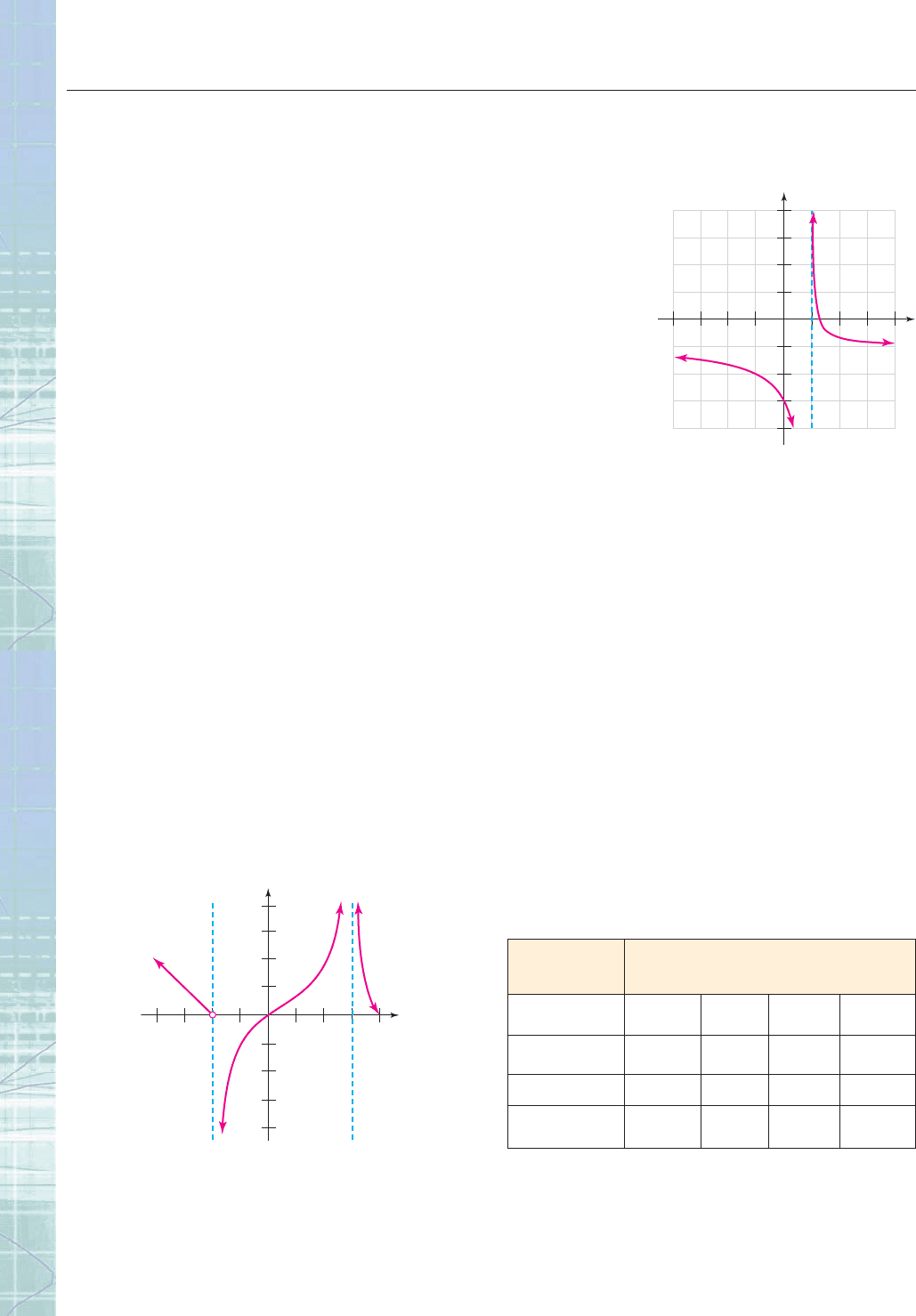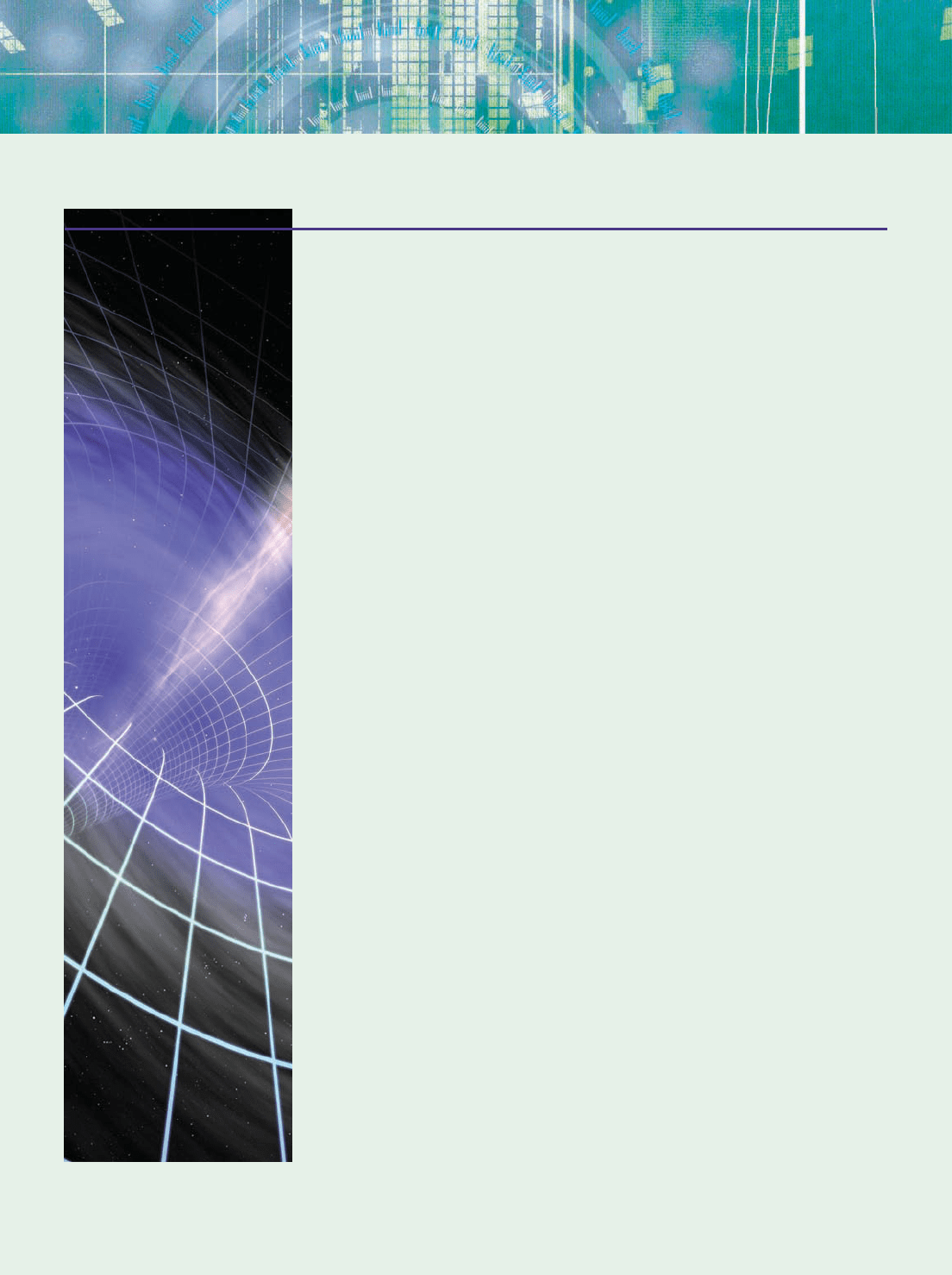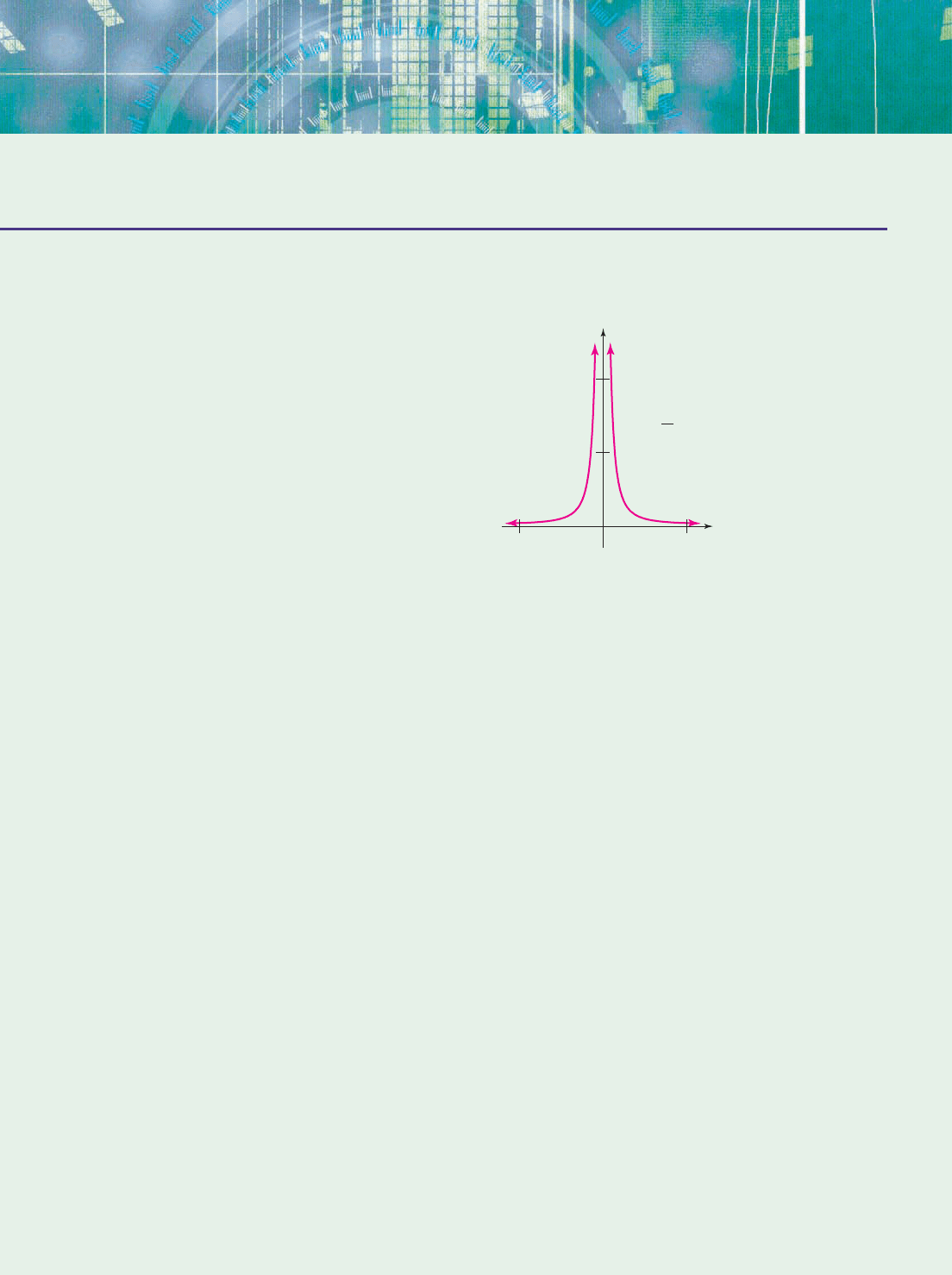Hungerford T.W., Shaw D.J. Contemporary Precalculus: A Graphing Approach
Подождите немного. Документ загружается.


5. (a) Graph the function whose rule is
x
2
if x 1
2x 3if1 x 1.
g(x)
2ifx 1
3 x if x 1
Use the graph to find the following limits.
(b) lim
x1
g(x) (c) lim
x1
g(x)
(d) lim
x1
g(x) (e) lim
x1
g(x)
6. Find the limit and show your work.
lim
x2
x
x
2
2
x
2
x
2
7. Find lim
x3
x
x
3
3
.
8. If f(x) x
2
, find lim
h0
f(3 h
h
) f(3)
.
9. (a) Use graphical or numerical means to find lim
x0
f(x), when
f(x) (e
x
1) ln (x).
(b) What is f(0)?
10. If f(x) x
2
5x 6, find f(x), where
f(x) lim
h0
f(x h
h
) f(x)
.
11. Find the exact value of lim
x
2
x
x
2
2
.
12. Use the formal (ed) definition of “limit” to prove that
lim
x2
(3x 1) 5.
Sections 13.3 and 13.4
13. Use the definition of continuity and the properties of limits
to show that k(x)
4x
8
2
7
x
2
is continuous at x 2.
14. Find each of the following limits, where f is the function
whose graph is shown below.
(a) lim
x2
f(x) (b) lim
x0
f(x)
(c) lim
x3
f(x) (d) lim
x3
f(x)
15. Determine whether the function g is continuous at x 3,
where
4x 17 if x 3
g(x)
4x 5ifx 3
.
2
2
22
x
y
926 CHAPTER 13 Limits and Continuity
16. The graph of a function f is shown below. Use it to find the
following:
(a) The vertical asymptotes of the graph
(b) lim
x
f(x)
(c) lim
x
f(x)
17. Determine all numbers at which the following function is
continuous:
5
x
if x 1 and x 0
.
g(x)
5x
2
if x 1
18. Find lim
x
. Show your work.
19. Taxis in a certain city cost $2.50 plus 30 cents for each 15
of a mile (or portion thereof). Let f(x) be the cost of travel-
ing x miles. Is f continuous on the interval
(a) [0, .2]? (b) [0, 1]?
20. Find lim
x
x
2
x
1
x
3
2
x
2
x
. Show your work.
21. For what values of b is the following function continuous
at x 3?
bx 4 if x 3
g(x)
b
2
x
2
2 if x 3
22. Find lim
x
(2
4
x
x
2
5)
2
(8
x
x
3
5)
. Show your work.
23. Fill the blanks in the following table. Enter “yes,” if the given
function is continuous on the given interval, or “no” if it is not.
24. Without graphing, find the horizontal asymptote of the
graph of f(x)
5x
5
7
x
3
x
5
2x 1
. Show your work.
4x
3
3x
2
2x 1
2x
3
3x
2
4x 5
10
1
2
2
1
3
3
20 302030 10
x
y
Interval
Function [0, 1] (0, 1] [0, 1) (0, 1)
f(x)
1
x
g(x)
x
2
x
2
1
H(x) x
K(x)
2x
2
x
2
1

927
DISCOVERY PROJECT 13 Black Holes
You can’t get here from there. Or, as the Eagles said in their 1976 song Hotel
California, “You can never leave.” A black hole is the ultimate “gotcha.” Nothing
can escape the gravitational attraction of a black hole—not even light. To under-
stand why this is so and to understand why the entire universe isn’t sucked into
some black hole, we need to use a little algebra and two ideas from physics: the
speed of light and escape velocity.
The speed of light (c in the famous equation E mc
2
) is approximately
3.00 10
8
meters per second. The speed of light is also the absolute maximum
velocity in this universe. Nothing moves faster. The escape velocity is the velocity
required for an object to escape the gravity of a planet or some other object.
Suppose that an object of mass m kilograms is moving with velocity v meters
per second. Its kinetic energy (energy of motion) is given by
KE
1
2
mv
2
.
Near the surface of a planet with mass M kilograms, the gravitational potential
energy (stored energy) of the object is given by
PE
Gm
r
M
,
where G 6.67 10
11
is the gravitational constant and r is the distance (in
meters) from the center of the planet. If the velocity is large enough, the kinetic
energy equals (or exceeds) the potential energy, and the object will escape. To find
the escape velocity, we solve the equation KE PE.
1
2
mv
2
Gm
r
M
Divide both sides by m and
multiply both sides by 2:
v
2
2G
r
M
(1) Take the square root of both sides: v
2G
r
M
meters per second.
Notice that the escape velocity v depends only on the mass M of the planet and the
distance r of the object from the planet’s center. The mass of the object itself is
irrelevant. For an atom or an ant or a rocket or the entire city of Atlanta, the escape
velocity is the same!
Under the preceding assumptions, find the escape velocity from the following
locations. Express all your answers in terms of kilograms (kg), meters (m), and
seconds. Express your final answers (but not any intermediate results) in scientific
notation (with the number between 1 and 10 rounded to two decimal places).
1. Surface of the earth. The mass of the earth is 5.97 10
24
kg, and its
radius is 6.38 10
6
m.
Chad Baker/Getty Images

928
2. Surface of the moon. The mass of the moon is 7.36 10
22
kg, and its
radius is 1.74 10
6
m.
3. A satellite at an altitude of 35,786 kilometers orbits the earth at the same
rate as the earth rotates. Satellites in such geosynchronous orbits stay
“parked” above the same spot. [Hint: A kilometer is 10
3
meters. Add the
altitude to the earth’s radius to find r.]
Gravity works in all stars to pull matter toward the center. The energy
released by fusion counteracts gravity. But when a star dies, gravity eventually
prevails. Depending on its mass, the star becomes a white dwarf, a neutron star, or
a black hole. In the case of a black hole, the mass is so large that gravity over-
comes even neutron repulsion, and the mass contracts to a singularity (a point).
As a dying star contracts, it reaches its Schwarzschild radius, R
S
, also
known as the event horizon. At the event horizon the escape velocity is c, the
speed of light. To find the Schwarzchild radius, we first solve the escape velocity
equation (1) for r:
(2) r
2G
v
2
M
Then set v c, so that R
S
2GM/c
2
. For points closer to the center/singularity,
the escape velocity is greater than c. But since nothing moves faster than light,
nothing escapes. Nothing. At greater distances, outside the imaginary sphere
defined by the Schwarzschild radius, everything is pretty much normal. The grav-
itational attraction and escape velocity are no different than they would be for any
regular star of the same mass. You just can’t see what is attracting you.
Use c 3.00 10
8
meters per second for the speed of light, and denote
the mass of the sun by M
sun
. Assume that M
sun
1.99 10
30
kg. Find the
Schwarzschild radius for black holes with the following masses.
4. Mass M equal to five times the mass of the sun (5 M
sun
)
5. M 8.4 M
sun
6. M 20 M
sun
The figure below is a depiction of the space-time fabric in the vicinity of a
black hole.
DISCOVERY PROJECT 13

929
A cross-section by a perpendicular plane through the singularity will resemble the
graph of f (x) 1/x
2
.
Although you may have thought that we would never make the connection, there
is a relationship between the physics of black holes and the algebra of limits. As
we saw in Section 13.4, the behavior of f(x) 1/x
2
near x 0 is described by
writing
lim
x0
x
1
2
.
Infinite limits such as this one can be rigorously defined (as ordinary limits were
in Special Topics 13.2.A) as follows.
Let f be a function and let a be a real number such that f (x) is defined for all
x in some open interval containing a (except possibly at x a). We say that the
limit of f (x), as x approaches a, is infinity, and write
lim
xa
f (x) ,
provided that for each positive number N, there is a positive number d (depending
on N) with this property:
If 0 x a d, then f (x) N.
To relate this definition to the preceding discussion, note that equation (1) defines
the velocity v as a function of the distance r; the rule of the function is
f (r)
2G
r
M
.
Finding the Schwarzschild radius amounts to finding d for this function f when
N c and a is the center/singularity of the black hole (so that r x a), as in
Exercises 4–6.
More about this topic can be found at the following Web sites:
http://antwrp.gsfc.nasa.gov/htmltest/rjn_bht.html
http://archive.ncsa.uiuc.edu/Cyberia/NumRel/BlackHoles.html
y
100
50
x
1
1
x
2
f(x)
1
This page intentionally left blank

931
Appendix 1 Algebra Review
This appendix reviews the fundamental algebraic facts that are used frequently in
this book. You must be able to handle these algebraic manipulations to succeed
in this course and in calculus.
1.A Integral Exponents
Exponents provide a convenient shorthand for certain products. If c is a real number,
then c
2
denotes cc, and c
3
denotes ccc. More generally, for any positive integer n,
c
n
denotes the product ccc
c (n factors).
In this notation, c
1
is just c, so we usually omit the exponent 1.
EXAMPLE 1
3
4
3
3
3
3 81, and
(2)
5
(2)(2)(2)(2)(2) 32.
For every positive integer n,0
n
0
0 0. ■
EXAMPLE 2
To find (2.4)
9
, use the V (or a
b
or x
y
) key on your calculator:
2.4 9 ENTER*
which produces the (approximate) answer 2641.80754. ■
Because exponents are just shorthand for multiplication, it is easy to deter-
mine the rules they obey. For instance,
c
3
c
5
(ccc)(ccccc) c
8
, that is, c
3
c
5
c
35
.
c
c
7
4
cc
c
c
c
c
c
c
c
cc
cc
c
c
c
c
c
c
c
cc
ccc c
3
, that is,
c
c
7
4
c
74
.
Similar arguments work in the general case.
*The ENTER key is labeled EXE on Casio calculators.
CAUTION
Be careful with negative bases. For instance, if you want to compute (12)
4
, which is a positive
number, but you key in () 12 4 ENTER, the calculator will interpret this as (12
4
) and
produce a negative answer. To get the correct answer, you must key in the parentheses:
(() 12) 4 ENTER.

932 APPENDIX 1 Algebra Review
EXAMPLE 3
4
2
4
7
4
27
4
9
and 2
8
/2
3
2
83
2
5
. ■
The notation c
n
can be extended to the cases in which n is zero or negative as
follows.
Note that 0
0
and negative powers of 0 are not defined (negative powers of 0 would
involve division by 0). The reason for choosing these definitions is that the multi-
plication and division rules for exponents remain valid. For instance,
c
5
c
0
c
5
1 c
5
,soc
5
c
0
c
50
.
c
7
c
7
c
7
c
1
7
1 c
0
,soc
7
c
7
c
77
.
EXAMPLE 4
6
3
1/6
3
1/216 and (2)
5
1/(2)
5
1/32. A calculator shows that
(.287)
12
3,201,969.857.* ■
If c and d are nonzero real numbers and m and n are integers (positive, nega-
tive, or zero), then we have these laws.
Multiplication
and Division
with Exponents
To multiply c
m
by c
n
, add the exponents.
c
m
c
n
c
mn
.
To divide c
m
by c
n
, subtract the exponents.
c
c
m
n
c
mn
.
Zero and
Negative Exponents
If c 0 and n is a positive integer, then
c
0
is defined to be the number 1;
c
n
is defined to the number
c
1
n
.
* means “approximately equal to.”
Exponent
Laws
1. c
m
c
n
c
mn
2.
c
c
m
n
c
mn
3. (c
m
)
n
c
mn
4. (cd)
n
c
n
d
n
5.
d
c
n
d
c
n
n
6.
c
1
n
c
n

SECTION 1.A Integral Exponents 933
EXAMPLE 5
Here are examples of the six exponent laws.
1. p
5
p
2
p
52
p
3
1/p
3
.5.
7
3
10
7
3
1
1
0
0
.
2. x
9
/x
4
x
94
x
5
.
3. (5
3
)
2
5
(3)2
5
6
.6.1/x
5
x
5
.
4. (2x)
5
2
5
x
5
32x
5
. ■
The exponent laws can often be used to simplify complicated expressions.
EXAMPLE 6
(a) (2x
2
y
3
z)
4
2
4
(x
2
)
4
(y
3
)
4
z
4
16x
8
y
12
z
4
.
Law (4) Law (3)
(b) (r
3
s
2
)
2
(r
3
)
2
(s
2
)
2
r
6
s
4
r
6
/s
4
.
Law (4) Law (3)
(c)
x
(
5
x
(
2
y
y
2
)
)
2
3
(
x
x
5
2
y
y)
6
2
(x
x
2
5
)
y
2
y
6
2
x
x
5
4
y
y
6
2
x
54
y
62
xy
4
. ■
Law (3) Law (4) Law (3) Law (2)
It is usually more efficient to use the exponent laws with the negative expo-
nents rather than first converting to positive exponents. If positive exponents are
required, the conversion can be made in the last step.
EXAMPLE 7
Simplify and express without negative exponents
a
(
a
2
(
3
b
b
2
c
5
3
)
)
2
c
2
.
SOLUTION
a
(
a
2
(
3
b
b
2
c
5
3
)
)
2
c
2
a
(a
2
(b
3
2
)
)
2
(b
2
(c
5
3
)
2
)
c
2
a
a
2
6
b
b
4
1
c
0
c
6
Law (4) Law (3)
a
2(6)
b
4(10)
c
61
a
4
b
6
c
7
a
c
4
b
7
6
. ■
Law (2)
Since (1)(1) 1, any even power of 1, such as (1)
4
or (1)
12
,
will be equal to 1. Every odd power of 1 is equal to 1; for instance,
1
x
1
5
CAUTION
(2x)
5
is not the same as 2x
5
. Part 4 of
Example 5 shows that (2x)
5
32x
5
and not 2x
5
.

(1)
5
(1)
4
(1) 1(1) 1. Consequently, for every positive
number c,
c
n
if n is even
(c)
n
[(1)c]
n
(1)
n
c
n
.
c
n
if n is odd
EXAMPLE 8
(3)
4
3
4
81 and (5)
3
5
3
125. ■
934 APPENDIX 1 Algebra Review
EXERCISES 1.A
In Exercises 1–18, evaluate the expression.
1. (6)
2
2. 6
2
3. 5 4(3
2
2
3
) 4. (3)2
2
4
2
1
5.
(3
)
2
2
2
(
1
2)
4
6.
(
(
4
4
)
)
2
2
2
7
1
7.
4
5
3
8.
7
4
3
4
2
9.
1
3
3
2
3
3
10.
5
7
2
2
7
2
11. 2
4
2
7
12. 3
3
3
7
13. (2
2
2)
2
14. (3
1
3
3
)
2
15. 2
2
3
3
3
2
2
3
16. 4
3
5
2
4
2
5
1
17.
2
1
3
2
1
4
18. 3
2
1
3
3
1
2
In Exercises 19–38, simplify the expression. Each letter rep-
resents a nonzero real number and should appear at most
once in your answer.
19. x
2
x
3
x
5
20. y
y
4
y
6
21. (.03)y
2
y
7
22. (1.3)z
3
z
5
23. (2x
2
)
3
3x 24. (3y
3
)
4
5y
2
25. (3x
2
y)
2
26. (2xy
3
)
3
27. (a
2
)(7a)(3a
3
) 28. (b
3
)(b
2
)(3b)
29. (2w)
3
(3w)(4w)
2
30. (3d )
4
(2d )
2
(5d )
31. a
2
b
3
a
3
32. c
4
d
5
c
3
33. (2x)
2
(2y)
3
(4x) 34. (3x)
3
(2y)
2
(2x)
35. (3a
4
)
2
(9x
3
)
1
36. (2y
3
)
3
(3y
2
)
2
37. (2x
2
y)
0
(3xy) 38. (3x
2
y
4
)
0
In Exercises 39–42, express the given number as a power of 2.
39. (64)
2
40. (1/8)
3
41. (2
4
16
2
)
3
42. (1/2)
8
(1/4)
4
(1/16)
3
In Exercises 43–60, simplify and write the given expression
without negative exponents. All letters represent nonzero real
numbers.
43.
x
4
(
x
x
3
2
)
3
44.
z
t
3
2
4
z
t
3
5
45.
c
e
6
4
2
c
e
3
3
46.
x
y
7
6
2
y
x
2
4
47.
a
a
b
b
2
c
c
3
2
d
d
4
2
48.
(3x
(
)
2
2
x
(
y
y
2
2
)
)
3
3
x
2
49.
b
a
6
4
2
50.
x
y
2
2
2
51.
d
c
5
3
2
52.
2
x
y
1
1
2
x
y
2
53.
3
y
x
2
3
2
y
x
3
2
54.
5
2
u
uv
2
v
2
2
2u
3
2
u
v
v
3
55.
(
(
a
a
b
3
b
2
2
c
c
3
)
)
2
1
56.
(
(5
2
c
cd
3
d
2
e
e
)
1
2
)
3
57. (c
1
d
2
)
3
58. [(x
2
y
1
)
2
]
3
59. a
2
(a
1
a
3
) 60.
a
b
2
2
b
a
2
2
In Exercises 61–66, determine the sign of the given number
without calculating the product.
61. (2.6)
3
(4.3)
2
62. (4.1)
2
(2.5)
3
63. (1)
9
(6.7)
5
64. (4)
12
6
9
65. (3.1)
3
(4.6)
6
(7.2)
7
66. (45.8)
7
(7.9)
9
(8.5)
4
In Exercises 67–72, r, s, and t are positive integers and a, b,
and c are nonzero real numbers. Simplify and write the given
expression without negative exponents.
67.
3
3
s
r
r
68.
4
4
2
(t
t
1)
69.
b
a
6
4
t
70.
(6
c
b
)
t
s
71.
(
(
c
c
t
b
r
b
s
s
)
)
r
t
72.
(a
(b
r
b
t
c
r
)
s
)
s
t

SECTION 1.B Arithmetic of Algebraic Expressions 935
ERRORS TO AVOID
In Exercises 73–80, give an example to show that the statement
may be false for some numbers.
73. a
r
b
r
(a b)
r
74. a
r
a
s
a
rs
75. a
r
b
s
(ab)
rs
76. c
r
c
r
77.
c
c
r
s
c
r/s
78. (a 1)(b 1) ab 1
79. (a)
2
a
2
80. (a)(b) ab
1.B Arithmetic of Algebraic Expressions
Expressions such as
b 3c
2
,3x
2
5x 4,
x
3
z
,
x
3
x
2
4
xy
x
y
p
are called algebraic expressions. The letters in algebraic expressions represent
numbers. A letter that represents a number whose value remains unchanged
throughout the discussion is called a constant. Constants are usually denoted by
letters near the beginning of the alphabet. A letter that may represent any number
is called a variable. Letters near the end of the alphabet usually denote variables.
Thus, in the expression 3x 5 c, it is understood that x is a variable and c is a
constant. The value of this expression depends on the value of the variable x. If
x 4, then
3x 5 c 3(4) 5 c 17 c,
and if x
1
3
, then
3x 5 c 3
1
3
5 c 6 c,
and so on.*
The usual rules of arithmetic are valid for algebraic expressions:
Commutative Laws:
a b b a and ab ba.
Associative Laws:
(a b) c a (b c) and (ab)c a(bc).
Distributive Laws:
a(b c) ab ac and (b c)a ba ca.
EXAMPLE 1
Use the distributive law to combine like terms; for instance,
3x 5x 4x (3 5 4)x 12x.
*We assume any conditions on the constants and variables necessary to guarantee that an algebraic
expression does represent a real number. For instance, in z
, we assume z 0, and in 1/c, we assume
c 0.
